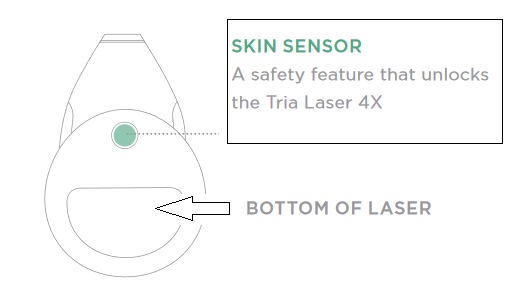Is Tria IPL or Laser
 [Affiliate disclosure, all links to amazon are affiliate links] There is quite a lot of confusion for customers about whether Tria laser is IPL or laser, and what are the difference between them. For those who want to reduce body hair permanently with Tria Laser this article will give you some hints and answers.
[Affiliate disclosure, all links to amazon are affiliate links] There is quite a lot of confusion for customers about whether Tria laser is IPL or laser, and what are the difference between them. For those who want to reduce body hair permanently with Tria Laser this article will give you some hints and answers.
We gathered 7 facts about Tria to help you get a better understanding before you go on and purchase it.
Fact No’ 1 – Tria Is Using Laser
Tria is LASER! It is using laser technology to perform the hair reduction process. The hand held device is using a laser energy for the hair removal procedure. The Laser which is used by the system is a 810 Nano-meter wavelength beam.
The main difference between laser and IPL, is that Laser is a narrow beam, very similar to a laser pointer you may have seen which makes a small tiny defined bright spot of light. The IPL on the other hand is a flash of light, which spreads on wide spectrum of light and not focused on one single beam. Like the camera flash you have in your phone.
The light-energy epilation process can happen when the light which is emitted by the device, is projected on the dark pigment of the hair in the follicle. The dark pigment absorbs more light than the lighter toned surrounding skin, and the energy is transformed into heat. This happens in a milli second and the hair is zapped.
The TRIA is focusing all its laser energy on one tiny spot of skin, the laser is able to penetrate the skin layers and zap the follicle inside the skin.
The best way to make the difference between laser device and IPL is to look at the applicator tip. Laser devices have a pencil wide window, from where the laser is projected. IPL devices have a wide glass window from which the flash is pulsed.
In the image below you can see an IPL machine and the TRIA tip. The differences are obvious, and will help differentiate you when you check for items online.
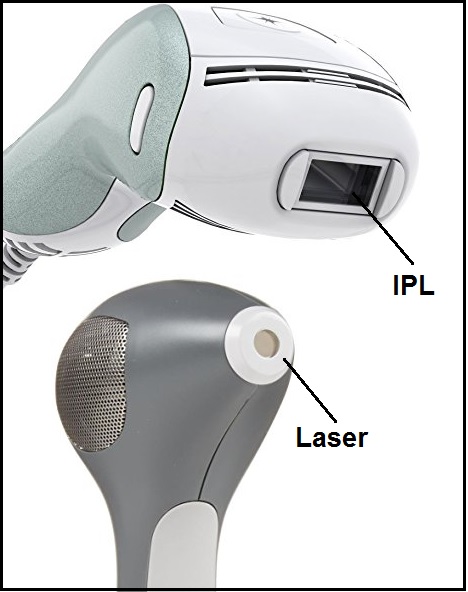 Fact No’ 2 – TRIA Pulses More Energy Than IPL
Fact No’ 2 – TRIA Pulses More Energy Than IPL
Most of the IPL or laser hair removal success is based on the amount of energy which can heat the hair. If the energy is too low, the hair might not heat and evaporate and no damage would be done to the root. Professional grade lasers use hundreds of Joules per cm2 of skin. Of course you can not use such machines at home, and a well trained technician should do them.
For home based laser devices, the TRIA laser has the highest light energy of them all. The TRIA laser 4X model at the highest level setting, has 22 joules per cm². It may not sound much compared to the professional beauty clinic machines, but comparing IPL systems can pulse at their highest level, 8-9 joules per cm².
The laser light is very focused and pin pointed, while the IPL is a flash of spread light. Even the TRIA precision unit, which is a compact small unit for fine touch ups, has at the highest setting level 20 joules per cm². Both of them more than any similar IPL home removal kit.
It is the light energy per cm² of skin, which makes the TRIA effective reducing hair regrowth.
Click here to shop for the TRIA laser hair removal device at Amazon.
3 – TRIA is FDA Approved
![]() Not every laser device has FDA approval. The TRIA has FDA approval for the home laser technology. In fact it was the first home laser system to obtain the FDA clearance. The FDA checks the manufacturers clinical trial claims and the safety features of the device to see it meets the requirement for safe usage.
Not every laser device has FDA approval. The TRIA has FDA approval for the home laser technology. In fact it was the first home laser system to obtain the FDA clearance. The FDA checks the manufacturers clinical trial claims and the safety features of the device to see it meets the requirement for safe usage.
There are other laser systems, not all of them have FDA approval for home use… Some are professional grade lasers which emit 100 joules of light per cm², and these have FDA approval but not for private home use… a regular customer may not know how to operate them safely enough.
The TRIA laser is approved only for specific skin color candidates and specific hair colors contrast and not for anyone. The FDA approval is only for those with skin types 1-4 in the Fitzpatrick skin color chart (the four on the left). These are ‘pale white’, ‘yellowish’ to ‘mildly tanned’ skin types. People with skin tones 5-6 (the two on the right) are not approved to use the TRIA.
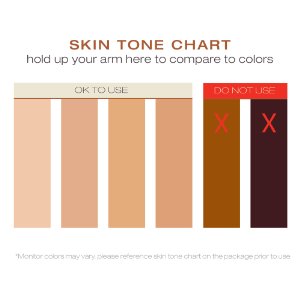 The TRIA is not approved for treating hairs which don’t have enough dark pigment in them. These would be red hair, ginger hair, gray hair, white and fair blond. The reason is that the light energy will have no dark pigment to target and the energy would heat the skin tissue.
The TRIA is not approved for treating hairs which don’t have enough dark pigment in them. These would be red hair, ginger hair, gray hair, white and fair blond. The reason is that the light energy will have no dark pigment to target and the energy would heat the skin tissue.
Fact No’ 4 – TRIA Has Two Safety Sensors
In order to get FDA approval the TRIA implemented two safety features in their device. These safety sensors are now a basic standard for all other home systems. Both sensors are located in the tip of the TRIA.
The first sensor is a skin color sensor. It detects in a second the color of the skin it is placed on before you pulse. This helps you make sure not to treat over dark skin. If the sensor notices dark skin, it will prevent the device from emitting laser. This prevents people using the laser not according to the FDA clearance and saves them the risk of skin burns.
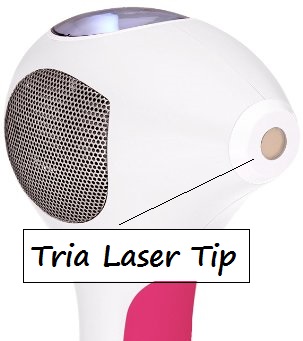 The second sensor is the skin contact sensor. It is the round ring around the tip, it has to pressed in order for the diode to emit laser.
The second sensor is the skin contact sensor. It is the round ring around the tip, it has to pressed in order for the diode to emit laser.
This is important to prevent accidental laser pulsing into blank air. The laser will project only when the tip is pressed by the skin. The main danger in lasers is eye damage, and this sensor prevents that.
Fact No’ 5 – TRIA Treatments Can be Painful
 The zapping targets the dark melanin in the hair. The hair itself is only ‘dead’ keratin and evaporating it is not what causing the pain. The heat with every pulse is felt by the surrounding skin, and this is what hurts. The follicle is nested in the skin and when it gets zapped, the skin feels the warm sensation.
The zapping targets the dark melanin in the hair. The hair itself is only ‘dead’ keratin and evaporating it is not what causing the pain. The heat with every pulse is felt by the surrounding skin, and this is what hurts. The follicle is nested in the skin and when it gets zapped, the skin feels the warm sensation.
There are plenty of ways to reduce the discomfort involved with the Tria treatments. Most people just use numbing gels and creams, and apply them before each area is treated. There are other ways like using ice packs, or ‘manipulating’ the skin and hair color, or lowering the energy level used to the lowest setting.
Before you checkout at Amazon, add a pack of numbing gel to the order.
Fact no’ 6 – The TRIA Capacity is 90,000 Pulses
In order to perform a full body hair reduction process, each area has to be treated several times, 4-6 times a few weeks a part. This is due to the fact that zapping the hair disables the root, only if the hair is connected to the root.
In each square inch of skin, only 15% of the hairs are connected to the root. All the rest have finished the growth stage (called Anagen) where the hair is connected to the root. The rest of the 85% of the hairs are just ‘resting’ in the follicle. Zapping them has no effect on the root.
 Each TRIA laser system is installed with approx 90,000 pulses of laser. This is enough to repeat the treatments several time and try to recapture the hairs which are at their anagen stage.
Each TRIA laser system is installed with approx 90,000 pulses of laser. This is enough to repeat the treatments several time and try to recapture the hairs which are at their anagen stage.
In the past, most home IPL systems had 1500 pulses of light per cartridge, which had to be replaced with a new one once it was emptied. In those days the TRIA capacity was overwhelming, with 90,000 (approx) pulses of laser.
But the times have changed, and the IPL devices began to use a quartz lamp, which could pulse 50,000 then 120,000 then 300,000 pulses like the advanced one today do. It would be fair to say the others have upgraded their systems to mach the TRIA abilities.
Each IPL pulse covers about 4-6 cm2 of skin, while the TRIA laser tips covers a 1 cm, so a 90,000 pulses are equivalent to 20,000 IPL pulses.
 The main difference is that when the IPL lamp is emptied most of them can be replaced, while the when the TRIA laser is emptied, a new device would be needed. As mentioned above each TRIA pulse has 3 times more energy than the strongest IPL setting, so the pros and cons get somewhat even.
The main difference is that when the IPL lamp is emptied most of them can be replaced, while the when the TRIA laser is emptied, a new device would be needed. As mentioned above each TRIA pulse has 3 times more energy than the strongest IPL setting, so the pros and cons get somewhat even.
When comparing a beauty salon, the TRIA cost is a fraction of the investment needed in a professional beauty clinic.
Fact No’ 7 – Its The Fourth Model Tria Launched
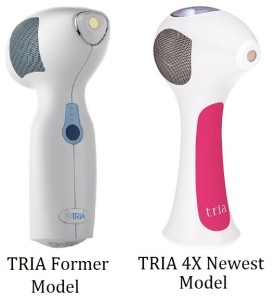 The official name of the TRIA you see today at Amazon, is TRIA 4X. This because it is the fourth generation they have. The TRIA generation 1, was the one who did the breakthrough for all he rest of the home hair removal devices. As it was the first ever laser unit approved for home use.
The official name of the TRIA you see today at Amazon, is TRIA 4X. This because it is the fourth generation they have. The TRIA generation 1, was the one who did the breakthrough for all he rest of the home hair removal devices. As it was the first ever laser unit approved for home use.
The first unit cost $1000 per unit, and it was bought like hot buns!
But the first units had some downsides which were upgraded in the following models. The charging time was shortened, new control panel with digital display was introduced, and the laser pulsing rate was increased.
Today you can find online the upgraded TRIA 4X model at Amazon sold at half the price of the TRIA first generation. Check the latest price Amazon offers and Customer reviews.
Good luck, soon (with some patience 🙂 ) you can say bye bye to the unwanted hair.

